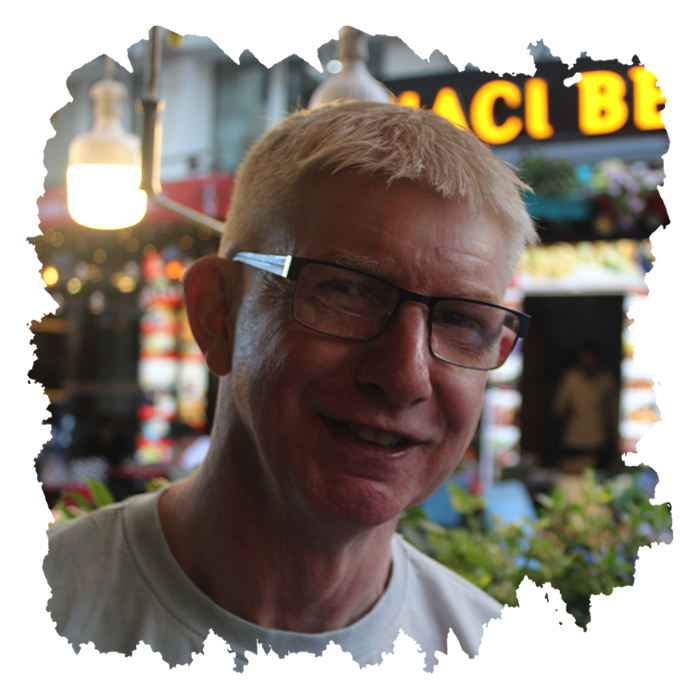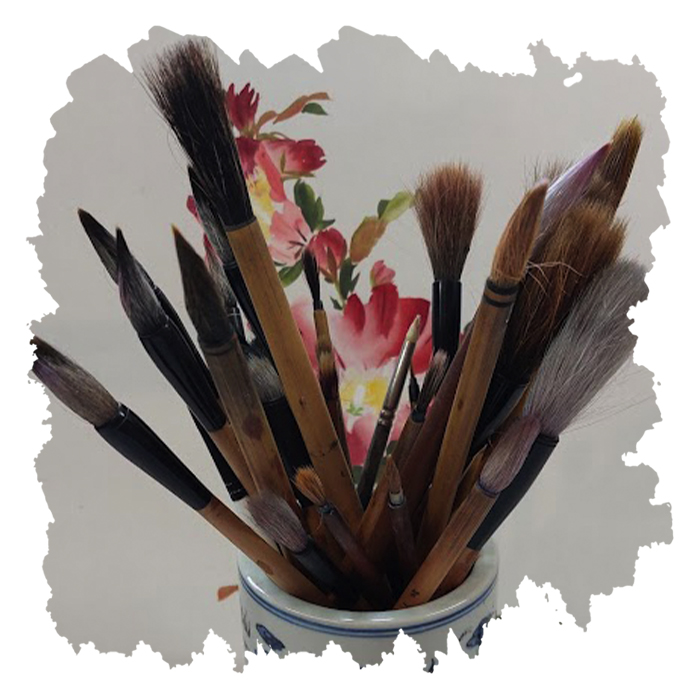
Martin
Martin grew up in the West Midlands, and throughout his life he has had various jobs within the catering industry, starting off as a commi chef and ending at head chef. He now works at Cardiff Metropolitan University catering for the students.
One constant throughout the years, is Martin’s love of art. At school, he was always top of the class in creative subjects. The awkward shift patterns of the catering industry meant that it was not until 2013 that he was first able to go the night school to pursue his interest in art. His first foray was in water colour painting.
Martin likes to have a go at painting anything, and he stumbled across Chinese brush painting on YouTube. He was fascinated how the ink, in just one stroke, made a mark. He was soon ordering paper, brushes and ink.
But no matter how he tried, it just wasn’t working as he hoped. He started to look for someone who could teach him, and just by chance came across Lisa Class. The only trouble was that Lisa lived in Devon, but that didn’t put him off, even though it was a two-and-half drive each way. With lessons booked and art box packed, off he went. They hit it off immediately and he took in everything he was taught. Martin was a constant questioner, asking her to show him everything. It is sad, therefore, that because of illness, Lisa passed away a couple of years ago.
Now Martin wants to pass on all the skills that he has learnt to other upcoming artists and take them on an unforgettable journey and guide them as Lisa did with him.
Chinese brush painting is never ending, and Martin still joins in with classes on Zoom. He makes the 4 hour drive all the way to the Yorkshire group for weekend workshops.
He went back to night school to learn how to draw. His skills are amazing, he never stops trying new things.
About my Artwork
I use only good quality materials which I buy from my supplier in Hong Kong. I use Xuan paper, Chinese ink and watercolours for my artwork.
Once my artwork has dried, I wet mount it. The process of wet mounting involves adding a backing paper to the artwork to stretch it out and to strengthen it.
I make my own glue, using flour and water, to back the painting. I lay the painting face down, apply the glue with a big brush. Once it’s been covered in glue, the backing paper, which is a lot bigger than the painting, is carefully laid on top, and the edges of the backing paper are glued lightly. I then lift the whole painting and place it on the drying board where it takes a couple of days to dry thoroughly.
On some paintings when I have used a lot of colour, the glue may cause the colours to run or bleed.
All works purchased come with a certificate of authenticity.


About Chinese Brush Painting
Chinese Brush Painting comes from calligraphy. Going back to the beginning of time when Emperors lived in their palaces, and wouldn’t venture out into the world, they hired artists who would be sent out to paint the outside world, farmland, villages and people. The artist then would show their work to the Emperor and his court.
Chinese brush painting is in the style of spontaneous meaning to take the essence or idea of the subject.
Before we even begin to paint, we need the “Four Treasures” - brush, rice paper, ink stick and ink stone.
To begin our journey, the delicate paper is laid out on a piece of soft felt. Water is dropped into the ink stone, as you pick up the ink stick, you clear your mind and let your body relax, close your eyes as you grind your ink stick to make ink, letting the good energy in, thinking of how your going to start your painting. Where will the first stroke be place on the white paper? You dip your brush in water, and then you gently let the brush take In the ink from the stone. The brush is in your hand, one drop of ink at the end of your brush, it feels like an ocean trembling in your hand, and as the brush glides on the paper with everything connecting at once, your energy, the brush, the paper, ink, you stand back and smile - there is the perfect stroke.
A master would say, ‘This is a journey of learning new skills. The mountain we climb is steep and never ending; there are resting places to see how far we’ve come. We take a breath on our journey and see what we have learnt helps us on our next path.’
Membership
Chinese Brush Painters Society.
Chinese Brush Painters Society Yorkshire.




